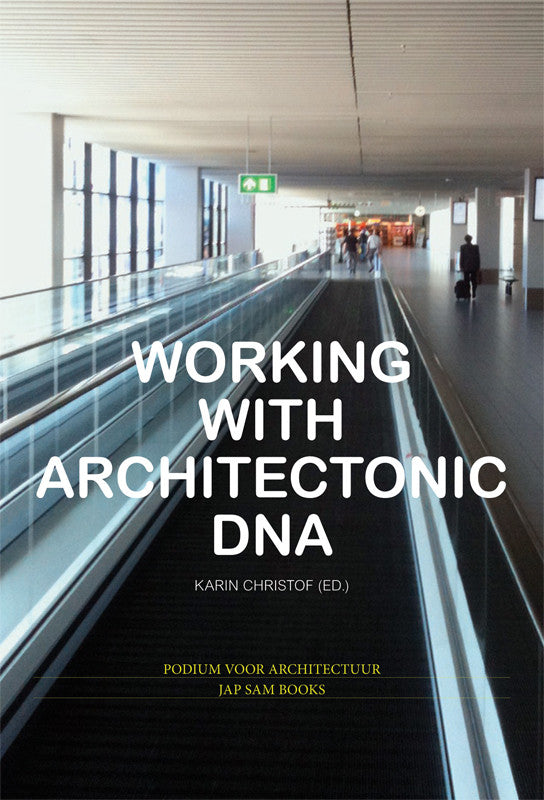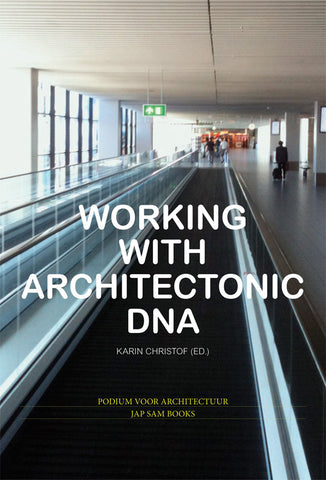Your cart is currently empty!
Working with Architectonic DNA
+++Working with Architectonic DNA+++
+++Karin Christof [ed.]+++
978-94-90322-22-9
Barbara Wais - Drahtzieher Design + Kommunikation
64
16.5 x 23.5 cm
Paperback
English
This publication was made possibly by Stimuleringsfonds voor Architectuur and Pier K.
This publication is published in cooperation with Podium voor Architectuur Haarlemmermeer en Schiphol
The publication, Working with Architectonic DNA, explores the phenomenon of designing complex architectural projects that require continuous modification including expansion and contraction. The departure point is Schiphol Airport in the Netherlands - an airport landscape of train lines, corporate architecture, highways, retail shops, etc. - a project that represents a space in constant flux as air travel patterns change depending on the world's economic state. Dutch architect, Jan Benthem, who has made numerous designs for Amsterdam Schiphol Airport since the 1960s, describes these projects as 'working with an architectonic DNA where the projects have to be finished in any stage of the design and construction'.
Departing from Jan Benthem's statement the publication reflects upon the idea of designing with an architectonic DNA and explores links with various disciplines. Texts and interviews by architects, urban planners, philosophers, interior designers and researchers investigate this architectural phenomenon from their professional points of view. The questions are: What is the essence, the conceptual basis of an 'architectonic DNA'? Is it possible to design with a so-called architectonic DNA? What are the relevant tools and methods to achieve this design? An epilogue by Benthem concludes the collection of reflective essays aimed at professionals, as well as students, within the field of architecture and urban planning.
With contributions by
Mathias Lehner, Karin Christof, Jan Benthem, Koos Bosma, Mario Campanella, Frederike Huygen, Andrew Jaffe, Duks Koschitz, Elke Krasny, Jannes Linders, Wim Nijenhuis, Gijs van Oenen, Frits J. Rotgans, Andreas Rumpfhuber, Robert Temel, Fridtjof Versnel, Jan Versnel.
Working with Architectonic DNA
€15.00
Working with Architectonic DNA
Working with Architectonic DNA
€15.00
978-94-90322-22-9
Barbara Wais - Drahtzieher Design + Kommunikation
64
16.5 x 23.5 cm
Paperback
English
This publication was made possibly by Stimuleringsfonds voor Architectuur and Pier K.
This publication is published in cooperation with Podium voor Architectuur Haarlemmermeer en Schiphol
The publication, Working with Architectonic DNA, explores the phenomenon of designing complex architectural projects that require continuous modification including expansion and contraction. The departure point is Schiphol Airport in the Netherlands - an airport landscape of train lines, corporate architecture, highways, retail shops, etc. - a project that represents a space in constant flux as air travel patterns change depending on the world's economic state. Dutch architect, Jan Benthem, who has made numerous designs for Amsterdam Schiphol Airport since the 1960s, describes these projects as 'working with an architectonic DNA where the projects have to be finished in any stage of the design and construction'.
Departing from Jan Benthem's statement the publication reflects upon the idea of designing with an architectonic DNA and explores links with various disciplines. Texts and interviews by architects, urban planners, philosophers, interior designers and researchers investigate this architectural phenomenon from their professional points of view. The questions are: What is the essence, the conceptual basis of an 'architectonic DNA'? Is it possible to design with a so-called architectonic DNA? What are the relevant tools and methods to achieve this design? An epilogue by Benthem concludes the collection of reflective essays aimed at professionals, as well as students, within the field of architecture and urban planning.
With contributions by
Mathias Lehner, Karin Christof, Jan Benthem, Koos Bosma, Mario Campanella, Frederike Huygen, Andrew Jaffe, Duks Koschitz, Elke Krasny, Jannes Linders, Wim Nijenhuis, Gijs van Oenen, Frits J. Rotgans, Andreas Rumpfhuber, Robert Temel, Fridtjof Versnel, Jan Versnel.



